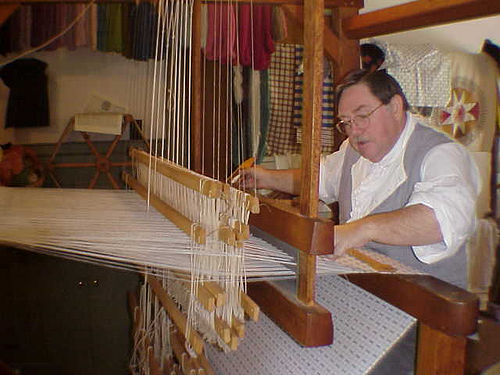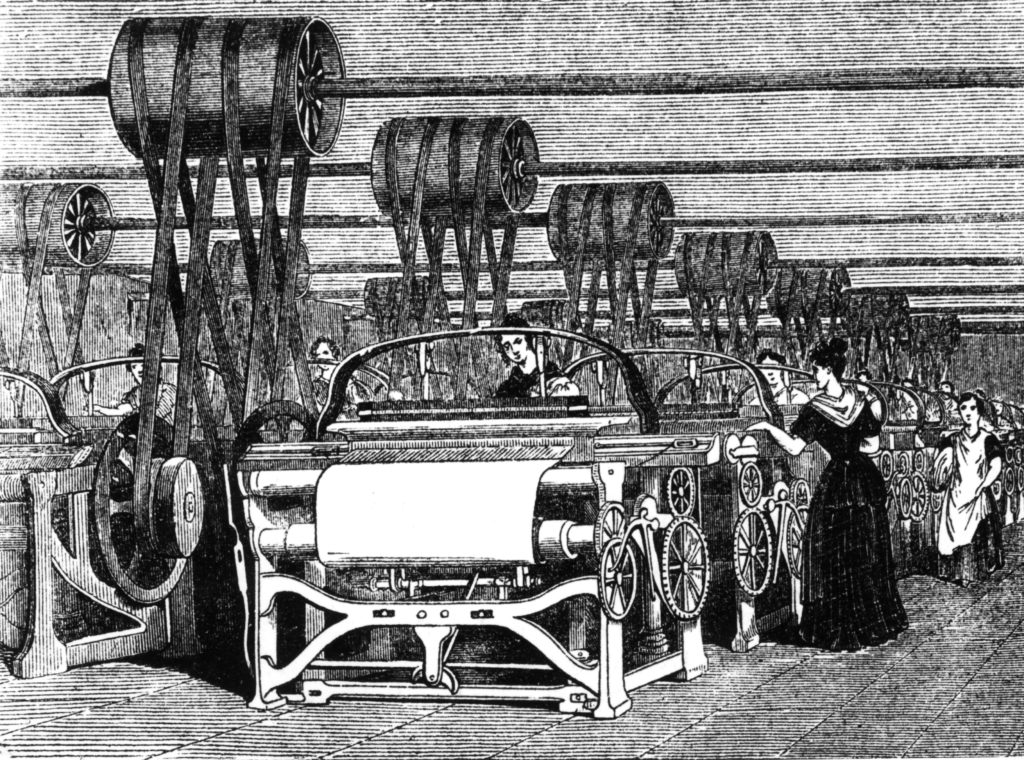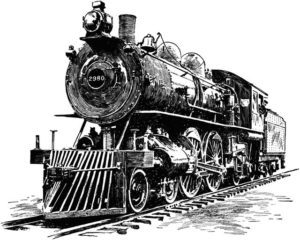Tom and I have been doing living history now for three years. We have worked in periods from 1740 through 1930, with most of our time in the 1700’s. During the 1700’s there weren’t a lot of changes in technology, at least as experienced by most people in the United States. But when you compare 1740 (Fort Frederica) with 1860 (English Camp) the changes in technology were huge.
 The entire Industrial Revolution occurred between 1740 and 1860. Wikipedia says it happened from 1760 to 1840. Before the Industrial Revolution, people were independent, subsistence farmers. Some people worked in cottage industries – so called because they worked in their cottages. Fabric was hand-woven on a loom by Dad. Mom and the children spun and prepared the yarn used. Everyone worked on the farm. Everyone was occupied producing what the family needed and maybe producing a little extra that could be sold.
The entire Industrial Revolution occurred between 1740 and 1860. Wikipedia says it happened from 1760 to 1840. Before the Industrial Revolution, people were independent, subsistence farmers. Some people worked in cottage industries – so called because they worked in their cottages. Fabric was hand-woven on a loom by Dad. Mom and the children spun and prepared the yarn used. Everyone worked on the farm. Everyone was occupied producing what the family needed and maybe producing a little extra that could be sold.
 But, starting in 1760, manufacturing was moved to factories that were increasingly automated. Textiles were the primary manufacturing industry. Several inventions allowed most fabric to be factory-produced by 1800. First the spinning jenny, then the automated drum carder, followed by water and steam-powered looms. Instead of the family working together to produce a little product, people “went to work” in factory towns that produced an increasing amount of product. The first textile factories were burned down by angry weavers who saw the factories as taking away their business.
But, starting in 1760, manufacturing was moved to factories that were increasingly automated. Textiles were the primary manufacturing industry. Several inventions allowed most fabric to be factory-produced by 1800. First the spinning jenny, then the automated drum carder, followed by water and steam-powered looms. Instead of the family working together to produce a little product, people “went to work” in factory towns that produced an increasing amount of product. The first textile factories were burned down by angry weavers who saw the factories as taking away their business.
Imagine what a difference these changes in technology made for the average family. I spend a lot of time interpreting textile arts: spinning, weaving, knitting. It takes me six hours to spin a bobbin-full of fine yarn. This doesn’t include the shearing of the sheep, washing the wool, and carding (brushing) it in preparation for spinning. If I had to make my own cloth, I would need to thread the loom and then spend weeks weaving the fabric needed. For the earliest settlers – in 1740 – there wasn’t any going to the store to buy a new coat. If you wanted a new coat, you had to wait six months until it could be made.
By 1860 all that had changed. You could go to the store and buy all the fabric you needed. Women didn’t spend hours spinning wool or cotton to weave. Not only could you buy the fabric, it was cheaper than what you could produce yourself with hours of labor. We talk about labor-saving devices today. Factory produced fabric was huge!
 Other changes in technology during this same period of time include the steam engine (1769), flush toilets (1775), the circular saw (1780), the threshing machine (1784), and the cotton gin (1794). In the early 1800’s inventions included matches (1805), steam-powered locomotives (1804), the electric light (1809), and the telegraph (1837). Many of these inventions were not developed for commercial use until years later. For instance, the flush toilet could not be widely used until cities had sewer systems (around 1900).
Other changes in technology during this same period of time include the steam engine (1769), flush toilets (1775), the circular saw (1780), the threshing machine (1784), and the cotton gin (1794). In the early 1800’s inventions included matches (1805), steam-powered locomotives (1804), the electric light (1809), and the telegraph (1837). Many of these inventions were not developed for commercial use until years later. For instance, the flush toilet could not be widely used until cities had sewer systems (around 1900).
When I think about the changes in technology between 1740 and 1860, I am amazed at what was done. The world I live in as a living historian at English Camp was significantly different than the world I inhabited at Fort Frederica.
